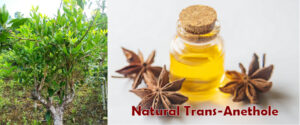
Anethole
Chemical Formula: C10H12O
Molar mass: 148.205 g/mol
Density: 0.998 g/cm3
Melting point: 20 to 21 °C (68 to 70 °F; 293 to 294 K)
Boiling point: 234 °C (453 °F; 507 K); 81 °C (178 °F; 354 K) at 2 mmHg
In recent years there has been an increasing interest in the activities of phytopharmaceutical products and biologically active substances of plant origin. Anethole is such a substance used from ancient times in traditional medicine in many countries. Nowadays it is widely used in the food and beverage industry. Its widespread use and accessible price justify carrying out extensive scientific research to support the traditional uses of anethole with scientific evidence. This review article summarizes the current knowledge of the traditional use of anethole, its pharmacological activities, and the possible mechanisms underlying its effects.
Anethole is clear, colorless to amber liquid with a sweet anise-like flavor. Anethole is only slightly soluble in water but exhibits high solubility in ethanol. This difference causes certain anise-flavored liqueurs to become opaque when diluted with water. This is due to the spontaneous formation of a microemulsion. Anethole is distinctly sweet, 13 times sweeter than sugar. It is used in many alcoholic drinks. It flavors Middle Eastern arak, Colombian aguardiente, French spirits absinthe, anisette and pastis, Greek ouzo, Bulgarian and Macedonian mastika, German Jägermeister, Italian sambuca, Dutch Brokmöpke, Portuguese, Peruvian, and Spanish anísado, Herbs de Majorca, Mexican Xtabentún and Turkish rakı. Anethole can cover unpleasant odors, so it is widely used as a masking agent in commodities, such as toilet soap, toothpaste, mouthwash, etc. This is the main use of anethole, about 80% of the total. It is used as a flavoring additive and scent in food industry products such as candy, baked goods, chewing gum, cigarettes, etc.
Anethole is a type of aromatic compound that occurs widely in nature in essential oils. It contributes to the distinctive flavors of anise and fennel (both in the botanical family Apiaceae), anise myrtle (Myrtaceae), licorice (Fabaceae), camphor, magnolia blossoms, star anise (Illiciaceae), and many other plants. Natural anethole occurs in high concentrations in anise oil (80-90%), star anise oil (over 90%), and fennel oil (80%).
Currently, Tech-Vina is the largest supplier of star anise oil in Vietnam with a capacity of 150 tons/year. By the end of 2021, Tech-Vina is going to start producing natural Anethole extracted from star anise oil and supply to the world market.
